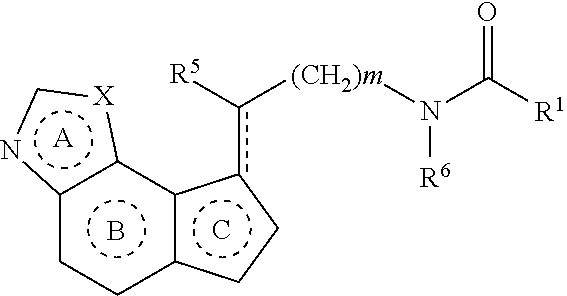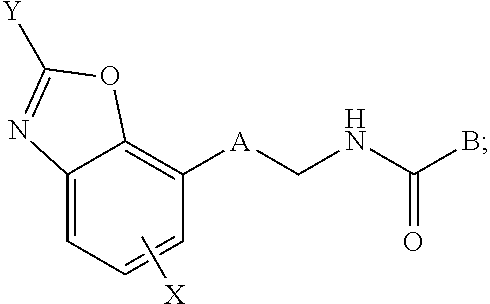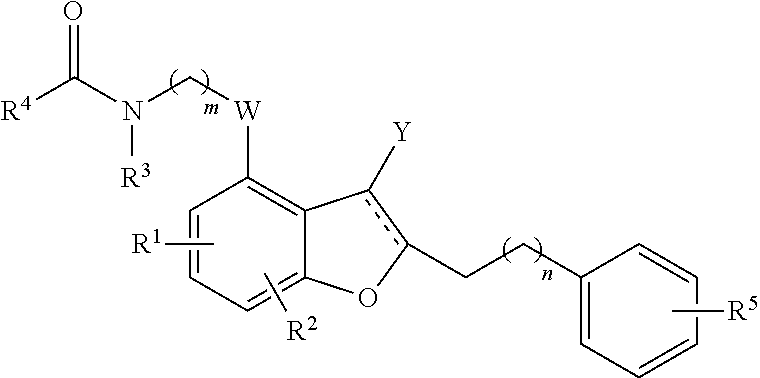Tricyclic compound and pharmaceutical use thereof
a tricyclic compound and compound technology, applied in the field of tricyclic compounds, can solve the problems that melatonin is not entirely suitable as a drug, and achieve the effects of superior metabolic stability, superior affinity for melatonin receptors, and superior intracerebral mobility
- Summary
- Abstract
- Description
- Claims
- Application Information
AI Technical Summary
Benefits of technology
Problems solved by technology
Method used
Image
Examples
reference example 1
4-Bromophenyl Acrylate
[0270]
[0271]To a solution of 4-bromophenol (15.1 g, 87.3 mmol) in tetrahydrofuran (170 mL) was added 60% sodium hydride (3.68 g, 91.6 mmol) under ice-cooling and the mixture was stirred for 15 min. A solution of acryloyl chloride (8.3 g, 91.6 mmol) in tetrahydrofuran (50 mL) was added, and the mixture was stirred for 15 min under ice-cooling. Water was added, and the solvent was evaporated under reduced pressure. The residue was extracted with ethyl acetate, washed with saturated brine and dried over anhydrous sodium sulfate. The solvent was evaporated under reduced pressure, and the residue was purified by silica gel column chromatography (ethyl acetate / hexane=20 / 80) to give the title compound (yield 100%).
[0272]1H-NMR (CDCl3) δ: 6.03 (1H, dd, J=10.5, 1.1 Hz), 6.31 (1H, dd, J=17.3, 10.5 Hz), 6.61 (1H, dd, J=17.3, 1.1 Hz), 7.03 (2H, d, J=9.1 Hz), 7.50 (2H, d, J=9.1 Hz).
reference example 2
4-Bromo-7-hydroxyindan-1-one
[0273]
[0274]To a mixture of aluminum trichloride (120 g) and sodium chloride (40 g) heated to 100° C. was added 4-bromophenyl acrylate (10.5 g, 50.7 mmol), and the mixture was stirred for 15 min. Then, the mixture was heated to 140° C., and the mixture was stirred for 45 min. The mixture was poured into ice-cooled water and extracted with ethyl acetate. The extract was washed with saturated brine and dried over anhydrous sodium sulfate. The solvent was evaporated under reduced pressure, and the residue was purified by silica gel column chromatography (ethyl acetate / hexane=20 / 80) and recrystallized (ethyl acetate / hexane) to give the title compound (3.82 g, yield 36%).
[0275]1H-NMR (CDCl3) δ: 2.68-2.83 (2H, m), 2.99-3.09 (2H, m), 6.71 (1H, d, J=8.8 Hz), 7.58 (1H, d, J=8.8 Hz), 9.01 (1H, s).
reference example 3
4-Bromo-7-hydroxy-6-nitroindan-1-one
[0276]
[0277]4-Bromo-7-hydroxyindan-1-one (3.06 g, 13.5 mmol) was suspended in acetic acid (20 mL), and acetic anhydride (1.66 mL, 17.6 mmol) and fuming nitric acid (838 μL, 20.2 mmol) dissolved in acetic acid (10 mL) were added. The mixture was stirred at room temperature for 3 hr. The solvent was evaporated under reduced pressure and the precipitated yellow crystals were collected by filtration to give the title compound (2.98 g, yield 79%).
[0278]1H-NMR (CDCl3) δ: 2.83-2.92 (2H, m), 3.08-3.16 (2H, m), 8.50 (1H, s), 10.99 (1H, s),
[0279]melting point: 149-151° C. (recrystallized from methanol),
[0280]Elemental analysis: for C9H6BrNO4
[0281]Found (%): C, 39.88; H, 2.40; N, 5.37.
PUM
 Login to View More
Login to View More Abstract
Description
Claims
Application Information
 Login to View More
Login to View More - R&D
- Intellectual Property
- Life Sciences
- Materials
- Tech Scout
- Unparalleled Data Quality
- Higher Quality Content
- 60% Fewer Hallucinations
Browse by: Latest US Patents, China's latest patents, Technical Efficacy Thesaurus, Application Domain, Technology Topic, Popular Technical Reports.
© 2025 PatSnap. All rights reserved.Legal|Privacy policy|Modern Slavery Act Transparency Statement|Sitemap|About US| Contact US: help@patsnap.com



